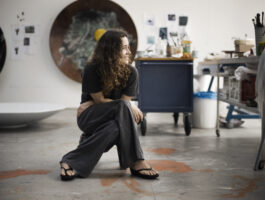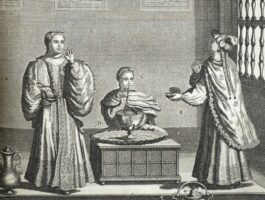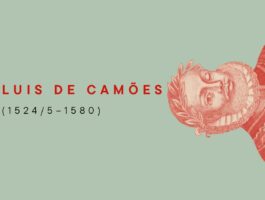 INTRODUCTION
INTRODUCTION
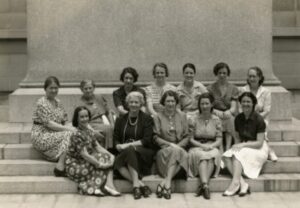 A UNIQUE STAFF
A UNIQUE STAFF
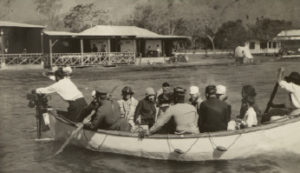 INTERNATIONAL EXPEDITIONS
INTERNATIONAL EXPEDITIONS
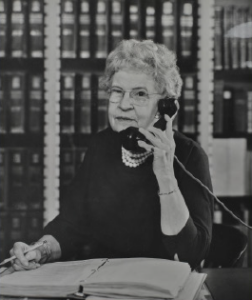 CLARA LOUISA PENNEY (1888-1970)
CLARA LOUISA PENNEY (1888-1970)
 ELEANOR E. SHERMAN FONT (1897-1982)
ELEANOR E. SHERMAN FONT (1897-1982)
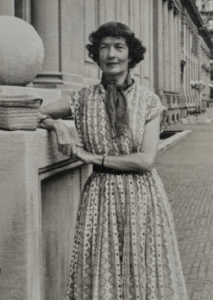 ELIZABETH DU GUÉ TRAPIER (1893-1974)
ELIZABETH DU GUÉ TRAPIER (1893-1974)
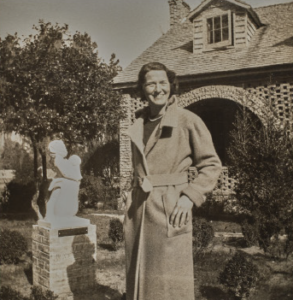 BEATRICE GILMAN PROSKE (1899-2002)
BEATRICE GILMAN PROSKE (1899-2002)
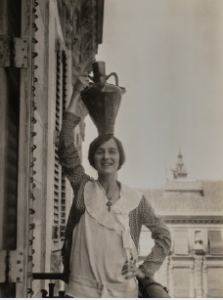 ALICE WILSON FROTHINGHAM (1902-1976)
ALICE WILSON FROTHINGHAM (1902-1976)
 FLORENCE LEWIS MAY (1899-1988)
FLORENCE LEWIS MAY (1899-1988)
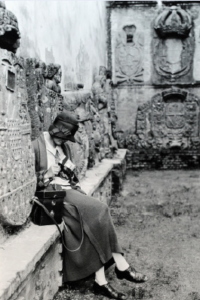 RUTH MATILDE ANDERSON (1893-1983)
RUTH MATILDE ANDERSON (1893-1983)
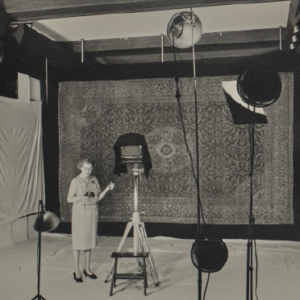 MARGARET JACKSON (1902-1986)
MARGARET JACKSON (1902-1986)
 DR. PRISCILLA E. MULLER
DR. PRISCILLA E. MULLER
Narrators: Maria Barney, Frances Cuadro, Cinthia Fernholz, Teresa Figueiras, and Natalia Gaiser.
Clara Louisa Penney
Clara Louisa Penney (1888-1970), graduated from Simmons College for women in 1912. She was an expert in Latin, and worked at the universities of Harvard and Maine, and at the Library of Congress in Washington and the New York Public Library. She was part of the first group of librarians that Huntington assembled to start cataloging his extensive collection of books from 1918. Like the other collaborators, she also traveled to Spain where she studied ancient books and manuscripts. In 1926, besides her intense cataloging work, she published a monograph dedicated to Góngora. The institution awarded her two medals: the Miter in 1937 and that of Art and Literature in 1953.
Eleanor Sherman Font
Eleanor E. Sherman Font (1897-1982) was the first deaf woman hired by Huntington in 1919. She worked at the HSA for over 54 years. She was the great-granddaughter of Thomas Hopkins Gallaudet, founder of the Gallaudet School, who was considered the father of education for deaf people in the United States. She began working as a library assistant, then became a researcher cataloger, then was put in charge of the collection of silver and gold artifacts, as well as globes. Later she accepted the position of curator of Iconography, responsible for an immense collection of photographs, as well as the engravings, on which she published several articles. Like the other women in the Society, and starting from 1922, she went on several sponsored study trips to Europe and Latin America.
Her lifelong interest in the work of deaf artists led her to organize the First International Exhibition of Fine and Applied Arts by Deaf Artists in 1934, with the help of the National Association of the Deaf. The exhibition was held at the Roerich Museum in New York City. Eleanor was awarded various medals by the Society where she also celebrated 50 years as curator in 1969.
Elizabeth du Gué Trapier
Elizabeth du Gué Trapier (1893-1974). Born in Washington in 1893, she worked at the Library of Congress before entering the Hispanic Society in 1918 were she started as Chief of the Catalogue Division. At the Hispanic Society she studied the paintings collection, and became Curator of Paintings in 1922, publishing a book about El Greco three years after. Her research is still used and respected by specialists in Hispanic art. Like her colleagues, field trips were essential during her formative years. From the 1920s she traveled all over the Iberian Peninsula and Europe. She wrote all three volumes of the Hispanic Society’s paintings collection from the Medieval period to 20th century. She met the most renowned art historians such as Camón Aznar, and Bernard Berenson, whom she met at his villa in Florence. She also met some of the artists included in her catalog for the 19th-20th centuries, such as Miguel Viladrich when she visited his castle/studio in Fraga, Huesca during her expedition of 1929.
Beatrice Gilman Proske
Beatrice Gilman Proske (1899-2002) was born on a farm in New Hampshire. According to the curator’s own words, her interest in books made her mother send her to Simmons College for women where she graduated as a librarian. In 1920 she joined the HSA as book cataloger, but seven months later she was transferred to the museum department where sculpture became her field of expertise. Like her co-workers, her formation was founded on the use of the bibliographic sources in the library, and the enjoyment of numerous trips to Europe commissioned by the Society during which she could study the sculpture collections not only in museums and private hands, but also in churches, and even convents with limited access. Moreover, Huntington believed that it was also essential to observe the artists’ creative process, and so Proske attended the School of American Sculpture for a year, and also visited the studios of many artists.
Alice Wilson Frothingham
Alice Wilson Frothingham (1902-1976) joined the institution in 1925 and retired in 1968, although like her colleagues, retirement never meant the end of her professional career as she continued researching and publishing articles. She trained as a librarian but upon entering the institution she decided to take up the decorative arts collection, focusing on ceramics and glass. She excelled in a field little known and studied in the USA and became a recognized scholar. In 1972 she was awarded the medal of merit by the Royal Academy of Fine Arts of San Fernando, Madrid (Spain). She traveled all over Europe studying the most important collections of ceramic and glass, like the one at the Louvre Museum, and the manufacture of Sevres in France. She was able to appreciate first-hand the beauty of the Manises ceramics, in the Valencian city that gave it its name, Manises. She also had access to one remarkable private collection, that of Manuel González Martí. She also met the sculptor, Mariano Benlliure. She was a prolific author of studies and monographs in the Society’s collection.
Florence L. May
Florence Lewis May (1899-1988) worked for almost 60 years at the HSA, having entered as a librarian and later became curator of textiles. The textile collection includes over 3,000 items from Spain, Latin America, and the Philippines, from the 13th to the 20th centuries. Florence knew and managed them all. To this day, the thoroughness of her research, her numerous manuscripts, and detailed descriptions of fabrics and types of clothing are all very impressive. She was a pioneer in the field of Spanish textiles, and her books and scholarly papers are cited by specialists to this day.
Ruth M. Anderson
Ruth Matilda Anderson (1893-1983) was hired as a photographer in 1921, and appointed curator of photography the following year, a position she held until 1924. From that year until 1954 she traveled on multiple expeditions. At the end of 1928 she was appointed curator of Iconography, but her work focused on research and collection material of ethnographic value. For decades she documented a world in transition, where century-old traditions and beliefs were disappearing or being modified with the developing times. Her most challenging assignment from Huntington was to be the specialist in ethnographic related subjects. It was through her tenacity and hard work that she was able to gather an extraordinary and unique photo archive, that together with her field notes is today the only living testament of a way of life that is forever lost. Through the help of her photographic work, she produced studies of academic value on topics such as historical and regional clothing and its symbolism, dance, religious and popular celebrations, local industries, etc. Everything she learned came from her experiences lived in the first person; she shared space and time with her informants and the people portrayed in her photographs. She was also very keen on depicting the life of women, and emphasizing their crucial contributions as custodians of a knowledge passed on through many generations.
Margaret Jackson
Margaret Jackson (1902-1986) graduated in Library Science and studied Spanish, French, and Latin at the Gallaudet School for the deaf. She joined the HSA in 1927 and carried out the most advanced photography experiments, although she did not have a photography background before entering the Hispanic Society. Because of her intense work photographing the library and museum collections at the HSA, she became an expert, and a specialist in the use of the X-Ray machine. X-Ray photographs were crucial for the study of some paintings, and an essential tool in the process of restoring works of art.
In Huntington’s mind photography was very important. He brought the most modern photo devices and developed the latest techniques of the time. He wanted to create a photographic archive of the collection, but also of other collections in order to build a photo library useful for the researcher.
Dr. Priscilla E. Muller
Dr. Priscilla E. Muller, now Curator Emeritus, is the only surviving staff member who personally knew and worked with the women represented in this exhibition. She has made outstanding contributions to the field of Spanish culture, including paintings, drawings, metalwork and jewelry. Born in 1930, she received her BA from Brooklyn College (1951) and completed her doctorate at the Institute of Fine Arts, NYU. She has written several books, including a History of Spanish Jewelry (1972) and a pioneering study of Goya’s Black Paintings (1984). From 1968 to 1995, she worked at the Hispanic Society first as Assistant Curator of Metalwork, then as Curator of Paintings and finally as Curator of the Museum. During this time, she made important additions to the collection, particularly in the area of drawings from the sixteenth through eighteenth centuries.
Independent researchers with ties to the Hispanic Society
The Hispanic Society has supported the research of many individuals over the years. Here are just two from a long list of women.
María de Maeztu y Whitney, director of the Residencia de Estudiantes at Madrid, was sent by the Spanish government to visit the principal American institutions for higher education of women. While on that mission she lectures under the Society´s auspices at the most important universities and women’s colleges in America.
Georgiana Goddard King was a specialist in Medieval art and Spanish literature, Huntington asked her to write a biography on the British architect George Edmund Street (1824-1881), and this work became one of the first publications by the Hispanic Society in 1916. Huntington offered Goddard a job at the museum, but she was more engaged with her teaching work at Bryn Mawr University where she founded the department of Art History. Huntington kept their friendship for many years, and he commissioned various expeditions to Spain (in 1915 and 1916). He also published a series of books by her about the art produced along the pilgrim route to Santiago de Compostela in Spain. Goddard’s research was published in 1920 in three volumes titled The Way of Saint James.
QUOTES AND TESTIMONIALS:
Ruth Brown (1976). Eleanor Sherman Font: Museum Pioneer. The Deaf American, 7–10.
Eleanor Sherman was the first deaf woman hired at the HSM&L:
“And all of us learned how to do everything in the library and museum, whether or not we had college degrees. In addition, each of us was assigned a subject such as painting, sculpture, ceramics, gold and silver work, old books (incunabula), textiles, etc., following Mr. Huntington’s ideas and system. At one time we all dropped everything else to forage through books to make cards for a portrait reference file listing the portraits of royal families and famous people of Spain and Portugal. We were encouraged, too, to establish reference files and notebooks for our own use and research.
[…]after 1915, only one man with curatorial/museum responsibilities, a Dr. Savage, was hired. He worked as a librarian from 1915 to 1935. Savage, as Eleanor Sherman recounts, stayed out of their work, ‘letting us women run the establishment’ .”
[…]The Society treated deaf people well, Eleanor stated, and except for our inability to use the telephone, we had equal opportunities for learning and recognition. In those lovely years we all studied and pioneered together. (Brown, Ruth. (1976). “Eleanor Sherman Font: Museum Pioneer”. The Deaf American, 7–10.).
Beatrice Gilman Proske. Excerpts from a Talk given at the Huntington Dinner, organized by the National Sculpture Society to honor the patrons at the National Arts Club. Nov. 15, 1984. HSM&L BGP papers (unpublished manuscript).
The opportunity to give this talk to what I know to be a sympathetic audience is very welcome, since it gives me a chance to acknowledge my indebtedness to the man who was responsible for my entire professional career.
[…]
By the time I arrived the collections had been greatly enlarged and a series of publications inaugurated, but there was not yet a permanent staff to care for the objects in the museum. To remedy this omission Mr. Huntington decided to draw upon the existing library staff. He had long thought that women would make good museum curators, and he was now ready to see what they could do.
One day he gathered us all together and announced his plan. The response was enthusiastic. He then distributed the subjects for which each person was to be responsible. Paintings were quickly appropriated by a girl who had lived in Europe. Ceramics, textiles and metalwork followed. When it came my turn I was at a loss what to say. My only exposure to any form of art had been one-term course in art appreciation taught by an interior decorator. Mr. Huntington came to my recue by asking if I would like to study the polychrome wood-carvings that are so characteristic of Spanish sculpture. I agreed at once, and then my real education began.
[…]“One of the principles that he [Huntington] passed on to us was that if you wanted to study the history of any of the arts, you must yourself learn the rudiments. Since sculpture was my province, he sent me down to study with Brenda Putnam, who was sharing a studio with Anna Hyatt.”
[…]Huntington was interested in people, in helping them develop their abilities to utmost. Once we were chosen, he made it his business to see that we were prepared for our undertakings. A knowledge of the Spanish language was imperative. Although most of us knew some Spanish, it was not enough; Miss Fuentes from Madrid was engaged to come and talk to us during lunch hour. A staff library was stocked with histories and classic authors for us to take home and read.
[…]
Huntington’s interest in people led him to employ a number of deaf women who became excellent librarians, photographers, and curators. One of the principles that he passed on to us that if you wanted to study the history of any of the arts, you must yourself learn the rudiments. Since sculpture was my province, he sent me down to a sculptor’s studio to observe and learn.
Beatrice Gilman Proske, when she refers to traveling:
Another requirement was obviously that we should know Spain at first hand. Mr. Huntington himself planned a trip for five of us with my mother as chaperone in 1922. He had a pages with a detailed map of Spain Xeroxed from Stieler’s Hand Atlas and marked out our route for us, chiefly in northern Spain because of the hot summer weather. We diligently visited museums and churches and made copious notes on our own subjects. After this first exploratory trip we were often sent off to study in place whatever we needed for the particular topic on which we were then engaged.
Proske, Beatrice G. Talk given at the Huntington Dinner, organized by the National Sculpture Society to honor the patrons at the National Arts Club. Nov. 15, 1984. (HSM&L archive Beatrice G. Proske papers).
[…]The staff shall know words and “refranes” and shall have met native creatures near to men—from mule to bed-bug. They shall pursue a word in its feathery meanings as an Englishman seeks the brush of a fox. They must block the burrows of escape and ride off with the trophy. They may write about their Spain. I think women should do it.
Getty Center for the History of Art and the Humanities and J. Paul Getty Trust. 1995. The Early Years of the Hispanic Society of America: Beatrice Gilman Proske. Los Angeles: J. Paul Getty Trust. page. 35 link
Florence L. May letter to Huntington dated August 1930, where she summarized her trip around the Iberian Peninsula, together with the photographer, Alice Atkinson, who was also both deaf and mute. Their mission was to study and record the traditional work of making laces and embroideries and also that of the local industries dedicated to their production. The letter described in rich detail their work and how important it was for the Society:
My dear Mr. Huntington:
It is with pleasure that I submit herewith my report for the trip to Spain, January-July 1930, together with a list of the places visited. We experienced no trouble in travelling, meeting everywhere with the characteristic courtesy of the Spaniard. Altogether, the finding of material more than fulfilled my expectations. Cataluña goes in more extensively for lace making than any other province. In Barcelona I took lessons in lace making which have proved to be of incalculable help to me. The pillows which I used are now on their way to be included in the collection of the Society. Castilla specializes in forms of embroidery as well as in lace making. Through the kind offices of Señor Ramón de Zubiaurre, I was able to obtain excellent material in Lagartera where he once worked on his Las encajeras de Lagartera, which painting is still hung in his home . If I may venture to say so, it would add to the collection in the Society of portraiture of costume in Spain. Since there were no opportunities to visit the remote districts of Andalucía, the churches in various pueblos near Sevilla amply repaid us in so far as examples of lace similar to the ones in the collection of the Society are concerned. Galicia uses many patterns like the ones at Almagro but, whereas the Almagro laces are sold all over Spain, those of Galicia are sent to Cuba or South America. Valencia makes a great deal of knotted nets. We were told that Luanco in the Asturias does similar work.
We photographed for the most part in museums and in churches. There were fine old mantillas in the exposition at Sevilla and we found much information in the exhibits held at the little Spanish houses. […] There were good laces in the museum of the Marquis of Cerralbo. Since Juan Lafora is preparing a catalogue of his art objects, he would only allow us to examine a few laces.
[…]After ascertaining at the Institut Internacional de cooperation intellectuelle, Paris that they would complete in December the publication of two volumes concerning the international congress held at Prague in 1928, I arranged to have sent to me in September the galley [sic] proofs of several articles on Spanish lace which would aid me greatly in my work. This combined with further research and the material already collected in Spain will, I hope, enable me to finish the book in December.
Thank you very much for this my third trip to Spain. To express my appreciation adequately is difficult but I hope that more than an echo of my enthusiastic interest will show in the work which I am privileged to do (HSM&L, Florence Lewis May papers).
Ruth M. Anderson. “The Hispanic Society of America.” Morningside Gardens News. New York, 1969. pp. 4-5.
“Art objects and valuable books require constant care, and from 1918 to 1922 Mr. Huntington expanded his staff by appointing a number of young women, several trained in library science and two in photography. To each he assigned a subject represented in the collection—painting, sculpture, ceramics, gold and silverwork, textiles, prints, printed books—to which he later added costume and manuscript decoration.
Despite their inexperience in the field of learning, he encouraged them to study and write immediately, beginning with short monographs published in Photostat, in which evaluations and criticisms were quoted from established authorities. Three wrote small books on a painter, a poet, and a sculptor, which were professionally printed.
[…]Women had been chosen because Mr. Huntington felt they have a natural capacity for museum work and because he wished to see women reap the entire credit for devoted research. Staff members who exercised diligence and judgment, loyally encouraged by Mr. Huntington, found themselves at the end of thirty or forty years in command of their subjects.”
Ruth M. Anderson papers. HSM&L archive
October 9th, 1928
Archer M. Huntington, Esquire
1 East Eighty-ninth Street
New York, New York
My dear Mr. Huntington:
During the two and a half months which Miss Spalding and I spent in Extremadura we made about two thousand photographs of dress, social life, domestic life, and industrial life. We travelled in a Ford car except in the northern part of the region, where several journeys had to be made with horses and mules. In Montehermoso (Cáceres) we found a wealth of material for our purpose, including the costumes represented by Sorolla in his painting of Extremadura. We photographed regional costumes in other towns in the province of Cáceres, but in the province of Badajoz regional dress had practically disappeared.
Distinctive industries were photographed in several towns: copper-working in Guadalupe, pottery-making in Arroyo del Puerco, the braiding of esparto grass in Campanario, the making of huge earthenware jars in Castuera, and cork-raising in Jerez de los Caballeros. The principal industries of the region, however, were sheep and pig-raising. We found the curing of hams still carried on in Montánchez, whose cool mountain air produces hams of especial excellence. We took care in Extremadura to show a proper appreciation of the pork, for, as Richard Ford has said, “The bacon of Catholic Spain is most orthodox: abhorred by Jew and infidel, it was the test of the true Christian.” Festival scenes were secured during Holy Week in Jerez de los Caballeros, a hill town, whose sloping streets and white houses furnished an effective background for processions of images and penitents.
Please accept my thanks for this opportunity to share in the work of recording the manners and customs of Spain. During this trip I have gained a greater degree of mastery of photography and of the Spanish language, and a more sympathetic understanding of the Spanish people, as the work unfolds and its purpose becomes clearer to me, I appreciate more deeply how great a privilege it is to be associated with The Hispanic Society of America.
Ruth M. Anderson papers. HSM&L Archive. Letter from Huntington congratulating Anderson for her book on Costumes from Extremadura (1951).
THE HISPANIC SOCIETY OF AMERICA.
OFFICE OF THE PRESIDENT
Stanerigg Farm,
Bethel, Conn.
September 27, 1951
My Dear Miss Anderson:
I received your excellent book on Costumes (Extremadura) this morning and its completion brought great pleasure to me. You have demonstrated once more the fact that we are not wrong at the Hispanic Society, in having worked out a plan available to each member and effective as that member sees fit to make it. It is certainly with great satisfaction that I look back over a period of nearly fifty years in which our staff has been walking in the path of creative endeavor and doing memorable work.
I congratulate you most heartily for having added this volume to the plan undertaken, a volume which contributes greatly to the assurance that our plan was not a mistake.
With cordial appreciation,
Yours Truly,
Miss Ruth M. Anderson,
The Hispanic Society of America, 155th Street West of Broadway, New York 32, N. Y.
51 West Tenth Street
New York 11, NY
October 20th, 1951
My dear Mr. Huntington:
Returning from Scotland, I was most happy to be greeted with your heartening letter of commendation. That you can speak of Spanish Costume-Extremadura as forming a unit in fulfilment of your plan for the Hispanic Society is immensely gratifying to me. It crowns the privilege I have so long enjoyed working within a plan that instantly unfolds new opportunities and new demands.
With many thanks for your letter, which is an inspiration to all the members of the Staff, and with (?) remembrance to Mrs. Huntington, I am.
Ruth M. Anderson
THE WOMEN OF THE HISPANIC SOCIETY
Curated by Dr. Noemí Espinosa
The exhibition presented here introduces the history of the many women who worked at the Hispanic Society of America (HSA) from 1918 to the late 1970s. Group photos and portraits of the female staff, together with their biographies and personal testimonies, tell the story of what it was like to work at the Hispanic Society. Most of these women began their careers as librarians, and many of them went on to become curators and experts in the art or literature of a culture that was initially unfamiliar to them. Their achievements were in great part driven by the founder of the Society, Archer M. Huntington, who was in many ways responsible for changing the lives and expectations of many of these women. We begin with a quote from a letter he wrote to his mother, one of the first instances in which he explains his idea of a museum staffed by women.
“Of course most of the objects of importance which we may find will remain in Spain, with collectors or in Museums. I shall always follow this method and if later, as I hope, a Museum may be built in New York, specimens can be had elsewhere than in Spain. All Europe has them. I am sure that what we need at home is such a collection or Museum where a staff of workers can devote its time to the study of Spain. but such a Museum must be an instrument of education for a group working together and contain objects and books that present the subject so thoroughly that later travel in the country will give an approach of understanding. The preparation of such a Museum may take many years but is well worth the undertaking. I think women would do such work best. When I get home I shall make the experiment. I know you will help me when you think it over – and after you have seen what Spain has to give.”
This is a quote from an unpublished manuscript in the HSM&L library. Huntington wrote to his mother while working at the archaeological site of Itálica, a former Roman city near Seville. “Italica and Santiponce”(1898), part II. p.59.
The following information includes quotes, testimonies, and publications of the women highlighted in this exhibition. The legacy of these employees lives on, as women continue to hold important roles to research, care for, and promote the art and library collections at the Hispanic Society. To learn more about the women at the Hispanic Society, please visit our YouTube channel.
The following is a comprehensive selection of books and articles, produced by the women curators of the Hispanic Society:
ANDERSON, Ruth Matilda. Spain. Costumes from photographs in the collection of the Hispanic Society of America. New York: Issued by order of the Trustees, 1930.
―Spain. Costume details. Jewelry. Ten illustrations from photographs in the collection of The Hispanic Society of America. New York: Issued by order of the Trustees, 1930.
―Spain. Costume. Details. Women´s Coiffure. Ten illustrations from photographs in the collection of The Hispanic Society of America. New York: Issued by order of the Trustees, 1930.
―Extremadura Costume. Women´s Festival Dress at Montehermoso, Cáceres. Ten illustrations from photographs in the collection of The Hispanic Society of America. New York: Issued by order of the Trustees, 1930.
Series Folders & Portfolios (Frances Spalding co-author):
―Costume and Jewelry; photographs in the collection. New York: Paul Overhage, 1931.
―Jewelry. Brazaleras. La Alberca, Salamanca. New York: The Hispanic Society of America, 1931.
―Choricero Costume. Candelario, Salamanca. New York: The Hispanic Society of America, 1931.
―Men´s capes and cloaks. La Alberca, Salamanca. New York: The Hispanic Society of America, 1931.
―Jewelry. Necklaces. La Alberca, Salamanca. New York: The Hispanic Society of America, 1931.
―Wedding Costume, La Alberca. New York: The Hispanic Society of America,1931.
―Women´s Coiffure, Candelario. New York: The Hispanic Society of America, 1931.
―Women´s Dress for Church. Candelario, Salamanca. New York: The Hispanic Society of America, 1931.
―Women´s Festival Dress. Candelario, Salamanca. New York: The Hispanic Society of America, 1931.
―Women´s Jewelry. Candelario, Salamanca. New York: The Hispanic Society of America, 1931.
―Costume of Candelario, Salamanca. From color plates in the collection of the Hispanic Society of America. Printed by order of the Trustees. New York: The Hispanic Society of America, 1932.
―Exhibition Illustrating Dances of Spain, at the HSA, July 2, 1938 to October 20, 1941. Introduction by MA. New York. 1938.
―Gallegan Provinces of Spain: Pontevedra and La Coruña. New York: The Hispanic Society of America, 1939.
―“Pleated Headresses of Castilla and Leon (12th and 13th Centuries)”. Notes Hispanic. New York: Hispanic Society of America, 1942.
―Tocados plisados de Castilla y León los siglos XII y XIII. Comisión Provincial de Monumentos y de la Institución Fernán González de la Ciudad de Burgos. Boletín 2º trimestre, 1949, 4º trim. 1949, año 28, núms.107, 19; pp. [142]-144, [341]-344; 1º trimestre, 1950, 2º trim.1950, año 49, núms. 110, 111, pp. [71]-74, [166]-167; Figs.1-30.
―Spanish Costume: Extremadura. New York: The Hispanic Society of America,1951.
―Costumes Painted by Sorolla in His Provinces of Spain. New York: Hispanic Society of America, 1957.
―The Golilla. A Spanish Collar of the 17th century. Reprinted from Waffen-und Kostumkunde. The Hispanic Society of America, 1969. vol. XI. núm. 1.
―“Chapines and Related Shoes (El chapín y otros zapatos afines)”. Translated by María Jesús Risco de Serranúm. Granada: Cuadernos de la Alhambra, 1969. núm.5. pp.16-41.
―“Platform Shoes and Related Slippers”. Granada: Cuadernos de la Alhambra, 1970.
―“Regional Dress”. Apollo. The International Magazine of Arts and Antiques. London: Denys Sutton. núm. XCV. abril, 1972.
―Hispanic Costume, 1480-1530. New York: Hispanic Society of America, 1979.
―“Spanish Dress Worn by a Queen of France”. Paris: Extrait de la Gazette des Beaus-Arts. Decembre, 1981. pp. 215-222.
―“The Hispanic Society of America”. Morningside Gardens News, (1969). New York. Pp. 4-5.
BURR HARDENDORFF, Grace. Hispanic Furniture. With examples in the collection of The Hispanic Society of America. Hispanic Notes & Monographs. New York: The Hispanic Society of America, 1941.
CONNORS McQUADE, Margaret. La colección de cerámica de Alcora: The Hispanic Society of America. Fábrica de Cerámica de Alcora; Museo de Bellas Artes de Castelló; The Hispanic Society of America. Valencia: Fundación Blasco de Alagón, 2005.
―Loza Poblana : The Emergence of a Mexican Ceramic Tradition. Dissertation, 2005.
―Splendor of Alcora: Spanish Ceramics of the Eighteenth Century. New York: The Hispanic Society of America, 2000.
― Talavera poblana: four centuries of a Mexican ceramic tradition. New York: Americas Society, 1999.
― “Las Cerámicas Españolas De La Hispanic Society of America (Archer Milton Huntington y Su Museo).” Boletín De La Sociedad Española De Cerámica y Vidrio, 1999.
ESPINOSA FERNÁNDEZ, Noemí. La fotografia en los fondos de la Hispanic Society of America: Ruth Matilda Anderson. Doctoral dissertation. Chapter 1, pp. 49-189 link
―Hallazgo de lo ignorado. Las fotografías de Ruth M. Anderson para la Hispanic Society of America, 1925. Museu del Pueblu d’Asturies and Museo casa Natal de Jovellanos. KRK Editores. Gijón, 2018.
―Los viajes de estudio y expediciones en la Hispanic Society of America. Congreso de Historia del Arte. “El Greco en su IV centenario”. Patrimonio Hispánico y dialogo intercultural. Toledo, 2014.
Invited essay: Archer M. Huntington’s “Dream Team”. American Annals of the Deaf. Gallaudet University Press. Volume 168, Number 2, Reference Issue, 2023. pp.187-201 10.1353/aad.2023.a912141. link
Excerpts from the article:
“Women, including deaf women, played a valuable role in the HSM&L from its inception, and even before it. There were many women from a wide range of disciplines, but mainly from academia and the arts. Many women enjoyed the benefit of receiving the financial support of the HSM&L and having at their disposal the extraordinary resources in its library. They also had the opportunity to correspond and work with academics and other experts in their respective fields and to visit the most important museums and collections, both private and public. They enjoyed study expeditions commissioned by Huntington, during which they were able to do fieldwork and study the subjects of their research in situ. This support was in some cases essential to advancing their professional careers, and in the cases of the women who worked as permanent staff, it meant, in many ways, a changing of career and expectations. Most of those women began their careers as librarians and later became experts in art, literature, and a culture that was initially unfamiliar to them”.
FROTHINGHAM, Alice Wilson. Catalogue of Hispano-Moresque pottery in the Collection of The Hispanic Society of America. New York: The Hispanic Society of America, 1936.
―Sigillate Pottery of the Roman Empire, from excavations in Spain made chiefly by the president of the Hispanic Society of America at Italica by Alice Wilson Frothingham, with 124 illustrations. New York: The Hispanic Society of America, 1937.
―Hispanic Glass, with examples in the Collection of the Hispanic Society of America. New York: Printed by order of the Trustees, 1941.
―Apothecaries´ Shops in Spain. New York: Printed by order of the Trustees, 1941.
―Talavera Pottery. New York: The Hispanic Society of America, 1944.
―Lustre Ware of Spain. New York: The Hispanic Society of America, 1951.
―Prehistoric Pottery in the Collection from El Acebuchal, site near Carmona, Province of Seville. New York: The Hispanic Society of America, 1953.
―An important American Collection of Hispanic-Moresque Pottery. Geneve: L’Academie Internationale de la Ceramique, 1954.
―Capodimonte and Buen Retiro Porcelains, Period of Charles III. New York: The Hispanic Society of America, 1955.
―Barcelona Glass in Venetian Style. New York: The Hispanic Society of America, 1956.
―A Pietà in Doccia Porcelain. New York: The Hispanic Society of America, 1957.
―Alcora Statuettes after Bronzes by Giovanni Bologna. New York: The Hispanic Society of America, 1957.
―The Count of Aranda: Portraits in Alcora Ceramics. New York: Printed by order of the Trustees, The Hispanic Society of America, 1960.
―Enameled Glass from the Spanish Royal Factory. New York: The Hispanic Society of America, 1961.
―Tile Altars by Niculoso Pisano & others at Tentudia, Spain. New York: The Hispanic Society of America, 1964.
―Panels by Three Tile Decorators of Seville. New York: The Hispanic Society of America, 1969.
―Tile Panels of Spain, 1500-1650. New York: Printed by order of the Trustees, The Hispanic Society of America, 1969.
―Vicente Alvaro, Pintor de Porcelana en Alcora. Madrid: Consejo Superior de Investigaciones Científicas. Instituto Diego Velázquez, 1970. Separata de Archivo Español de Arte. Tomo XLIII. núm. 171. pp. 329-338.
―Fine European Earthenware: An Exhibition Presented at the Museum of Fine Arts, St. Petersburgh, Florida. May 8 Through June 10, 1973. [Exhibition catalog by Alice Wilson Frothingham]. St. Petersburg, Fla: Museum of Fine Arts, 1973.
―The Art of European Glass from 1600 Through 1800: An Exhibition Presented at The Museum of Fine Arts, St. Petersburg, Florida. March 8 Through April 17. Alice Wilson Frothingham; Jessie McNab; Dorothy M. Dartt (ed.). St. Petersburg, Fla: Museum of Fine Arts, 1977.
GILMAN PROSKE, Beatrice. Gregorio Fernández. New York: The Hispanic Society of America, 1926.
―Brookgreen Gardens catalogue of sculpture. Brookgreen, S.C.: Printed by order of the Trustees, 1936.
―Robert A. Baillie, Carver of Stone. Brookgreen, S.C.: Printed by order of the Trustees, 1946.
―Castilian Sculpture. New York: Hispanic Society of America, 1951.
―Pompeo Leoni; Work in Marble and Alabaster in Relation to Spanish Sculpture. New York: Hispanic Society of America, 1956.
―Dos estatuas de la familia Cárdenas, de Ocaña. Madrid: Consejo Superior de Investigaciones Cientificas (CSIC), Instituto Diego Velázquez, 1958.
―Dos estatuas de la familia Cardenas, de Ocaña. Madrid: Consejo Superior de Investigaciones Científicas, Instituto Diego Velázquez, 1959.
―“Juan Martínez Montañés. A commission for Santo Domingo”. Reprinted from the Gazette des Beaux-Arts. With the addition of transcriptions of documents in the Library of the Hispanic Society of America. New York 1960. pp. 79-93.
―Archer Milton Huntington. Printed by order of the Trustees. New York: The Hispanic Society of America, 1963.
―Luisa Roldán at Madrid. New York: The Hispanic Society of America, 1964.
―The Use of Jet in Spain. Madrid: Editorial Castalia, 1966.
―“Studies in Memory of Ramón Menéndez Pidal”. Hispanic Review. Pennsylvania, Ct.: University of Pennsylvania, Nov. 1970. vol. 38.
VVAA (general studies produced and edited by the HSA staff):
HISPANIC SOCIETY OF AMERICA. Hispanic Society of America; Emily Johnson De Forest; Edwin Atlee Barber. Catalogue of Mexican maiolica belonging to Mrs. Robert W.de Forest, exhibited by the Hispanic Society of America, February 18 to March 19, 1911. New York: The Hispanic Society of America, 1911.
―An exhibition of books relating to Miguel de Cervantes Saavedra in commemoration of the tercentenary of his death, held at the building of the Hispanic Society of America from the 15th of April until the 1st of May. New York: The Hispanic Society of America, 1916.
―Hispanic Society of America. Valladolid, Birthplace of Philip II. Spanish houses; monographs of the Hispanic Society of America. núm. 1. New York: The Hispanic Society of America, 1923.
―Hispanic Society of America. Handbook. Museum and Library Collections. New York: Printed by order of the Trustees, 1938.
―Translations from Hispanic Poets. Hispanic Notes & Monographs. New York: Hispanic Society of America, 1938.
―A History of the Hispanic Society of America. Museum and Library 1904-1954: With a survey of the collection by members of the staff. New York: Hispanic Society of America, 1954.
JOHNSON, Ada Marshall. Hispanic Society of America. New York: [s.n.], 1944.
―Hispanic Silverwork. New York: Print by Order of the Trustees, 1944.
―Spanish Jewellery of the Late Renaissance. New York: Hispanic Society of America, 1962.
JOHNSON, Ada Marshall; WILSON FROTHINGHAM, Alice; ANDERSON, Ruth M; ROSS, Marvin C. The Royal Factory for Silversmiths, Madrid. New York: Hispanic Society of America, 1942.
LEWIS MAY, Florence. Catalogue of Laces and Embroideries in the collection of the Hispanic Society of America. New York: The Hispanic Society of America, 1936.
―Hispanic Lace and Lace Making. New York: Printed by order of the trustees, 1939.
―Silk Textile of Spain. Eight to Fifteenth Century. New York: The Hispanic Society of America. Printed by order of the Trustees. Hispanic Notes and Monographies. Peninsular Series. New York: The Hispanic Society of America, 1957.
―The Textile Collection. New York: The Hispanic Society of America, 1972.
― Rugs of Spain and Morocco. Chicago: University of Chicago Press, 1977.
McVAN, Alice Jane. Spanish Darwfs. New York: Hispanic Society of America, 1942.
―Tryst. New York: Printed by order of the Trustrees, Hispanic Society of America, 1953.
―Antonio Machado. With translations of selected poems. New York: The Hispanic Society of America, 1959.
MULLER, Priscilla E. Francisco Pacheco as a Painter. New York: The Students of the Institute of Fine Arts, 1961.
―Treasures of Spanish Painting at Paris. [Paris, Musée Des Arts Décoratifs, 1963]. [Detroit]: Print. Joh. Enschedé en Zonen, 1963.
―The Drawings of Antonio del Castillo y Saavedra. Ann Arbor, Michigan: University Films, 1964.
―The so-Called Ex-Voto of Hernan Cortés. New York: Hispanic Society of America, 1968.
―Jewels in Spain, 1500-1800. Hispanic Notes & Monographs. New York: Printed by order of the Trustees, the Hispanic Society of America, 1972.
―Goya’s “Black” Paintings: Truth and Reason in Light and Liberty. Hispanic Notes & Monographs. New York: Hispanic Society of America, 1984. Sixth edition.
―A Goya Oil Sketch for an Officer’s Portrait. New York: Hispanic Society of America, 1984.
MULLER, Priscilla E.; BURKE Marcus B.; BANNER Lisa A.: From Goya to Sorolla: Queen Sofía Spanish Institute Salutes The Hispanic Society of America on its 100th Anniversary. New York: The Hispanic Society of America, 2005.
MULLER, Priscilla E.; LUNA, J.J. De Goya a Zuloaga. La Pintura española de los siglos XIX y XX en The Hispanic Society of America. Madrid: Ediciones El Viso, 2000.
MULLER, Priscilla E.; MATILLA, José Manuel. Dibujos españoles en la Hispanic Society of America: del siglo de Oro a Goya. Madrid: Museo Nacional de Prado, 2006.
PENNEY, Clara L. Luis Góngora y Argote (1561-1627). New York: The Hispanic Society of America, 1926.
―List of Books Printed before 1601 in the Library of the Hispanic Society of America with list of Books Printed 1601-1700. New York: The Hispanic Society of America, 1929-38
―Catalogue of Publications. With fifty-five illustrations. New York: The Hispanic Society of America, 1943.
―List of Books Printed before 1601 in the Library of the Hispanic Society of America. New York: The Hispanic Society of America, 1955.
― An Album of Selected Bookbindings. New York: The Hispanic Society of America, 1967.
PURSCHE, Anna. “Scenes of Lima, attributed to Pancho Fierro”. Notes Hispanic. New York: The Hispanic Society of America. Printed by order of the Trustees, 1944. vol. IV. pp. 93-131.
SIDER, Sandra. “Ruth Matilda Anderson: Biographical Sketch”. Ruth Matilda Anderson: Fotografías de Galicia 1924-1926. [exh. Cat., Centro Galego de Artes da Imaxe]. La Coruña: The Hispanic Society of America, Xunta de Galicia y Centro Galego de Artes da Imaxe, 1998.
STAPLEY BYNE, Mildred. Tejidos y bordados españoles. Madrid: Editorial Voluntad, S.A., 1924.
―Popular weaving and embroidery in Spain. New York: W. Helburn, 1924
―The Sculptured Capital in Spain; A Series of Examples Dating from the Sixth to the Sixteenth Century. New York: W. Helburn Inc, 1926.
―Forgotten Shrines of Spain. With a map and 67 doubletones from photographs by Arthur Byne. Philadelphia, London: J.B. Lippincott Company, 1926.
STAPLEY, Mildred and Arthur Byne. Rejería of the Spanish Renaissance. A collection of photographs and measured drawings with descriptive text. New York: The de Vinne Press, 1914.
―Spanish Ironwork. New York: The Hispanic Society of America, 1915.
―Spanish Architecture of Sixteenth Century. General View of the Plateresque and Herrera Style. New York: C.P. Putman’s Sons y The Hispanic Society of America, 1917.
―Decorated Wooden Ceilings in Spain. London y New York: C.P. Putman’s Sons, 1920.
―Spanish Interiors and Furniture. New York: William Heilburn, 1921-1922.
―Spanish Gardens and Patios. Philadelphia: J.B. Lippincott Company, 1924.
―Majorcan Houses and Gardens. A Spanish Island in the Mediterranean. New York: W. Helburn, 1928.
―Repertorio de muebles é interiores españoles (siglos XV á XVIII). Fotografía, diseños y textos. México: Grijalbo, 1958.
―Spanish Interiors and Furniture. Photographs and drawings. New York: Dover Publications, 1969.
TRAPIER, Elisabeth du Gué. El Greco. New York: The Hispanic Society of America, 1925.
―Catalogue of Paintings (19th and 20th centuries) in the collection of the Hispanic Society of America. New York: The Hispanic Society of America, 1932.
―Daniel Urrabieta Vierge in the collections of The Hispanic Society of America. Hispanic Notes and Monographs. New York: The Hispanic Society of America, 1936
―Eugenio Lucas y Padilla. New York: The Hispanic Society of America, 1940.
―Velázquez. New York: Printed by order of the Trustees, The Hispanic Society of America, 1948.
―Ribera. New York: The Hispanic Society of America, 1952.
―Luis de Morales and Leonardesque influences in Spain. New York: The Hispanic Society of America, 1953.
―Goya: A Study of his Portraits, 1797-1799. New York: The Hispanic Society of America, 1955.
―Valdés Leal, baroque concept of death and suffering in his paintings. New York: The Hispanic Society of America, 1956.
―The School of Madrid and Van Dyck. New York: Hispanic Society of America, 1957.
―El Greco: early years at Toledo, 1576-1586. New York: The Hispanic Society of America, 1958.
―Valdés Leal, Spanish baroque painter. New York: The Hispanic Society of America, 1960.
―“A Sketch Book by the Young Vierge”. New York: Apollo, October 1961. no. 75. pp. 93-96
―“Only Goya”. The Burlington Magazine. 102, no. 685. London: The Burlington Magazine, 1960. pp. 158-161
―Goya and his sitters; a study of his style as a portraitist. New York: Printed by the order of the Trustees, The Hispanic Society of America, 1964.
List of women from 1918 to the present
Beatrice Chandler Allegaert, Marion Thompson Hoag, Renate Kugel Alpert, Margaret E. Jackson, Emily Leeds Andem, Mabel Johns, Alice D. Atkinson, Cynthia Kochlin Kotchin, Sara Tuck Austin, Florence Armstrong Lux, Virginia Rost Barlow, Florence Lewis May, Estelle Maxwell Braddock, Maureen McLaughlin, Nancy Tyree Breunig, Alice J. McVan, Marybelle Minetree Brubaker, Nettie Miller, Delia Kittleson Catuna, Doris Balance Orman, Ellen Cobb, Elizabeth Moss Osborne, Mabel Armstrong Conklin, Ophelia Osborne, Florence B. Crammatte, Alice Studt Palazzi, Ione C. Dibble, Jane Palmer, Sophie Boatwright Dobbins, Elizabeth McLeod Pinckney, Joan Dochtermann, Sarah Tredwell Ragna, Helen E. Fish, Lillian Gourley Rakow, Eleanor Sherman Font, Anderson Yeager Rogers, Margaret Sherman Gillen, Annabel Eberhardt Sharr, Mabel Hall, Ann Lister Siebert, Mildred Stapley Byne, Mary E. Armstrong, Isabel K. Macdermott, Florence Shea, Margaret E. White, Catherine M. Allyn, Anna Pursche, Marion E. Dunbar, Jean Rogers Longland, Ada Marshall Johnson, Adelaide Marie Meyer, Frances Spalding, Ruth M. Anderson, Alice Wilson Frothingham, Elizabeth du Gué Trapier, Beatrice Gilman Proske, Dorothy Morse Dartt, Gertrude Alfaretta Holler, Cyntia Jane Milton, Edit H. Negley, Clara Luisa Penney, Anna Mary Raymond, Meta Harssen,Gaynor, Amise P. Kan, Jessica Meapher, Dorothy I. Higgins, Della C. Catuna, Sally Farrar, Marquee (Mason), Lydia Dufour, Priscilla Muller, Vivian A. Hibbs, Margaret Connors McQuade, Mencía Figueroa, Hélène Fontoira Marzin, Natalie Espino, Noemí Espinosa, Michelle Nani, Vanessa Pintado, Katia Azze, Maria Barney, Pearl Chin, Frances Cuadro, Lisa Dowd, Cinthia Fernholz, Teresa Figueiras, Alexandra Frantishek Rodriguez, Natalia Gaiser, Amelia Wright, Ysabel Abreu, Breanna Gartner, Gabbi Kester, Alejandra Pasquel

